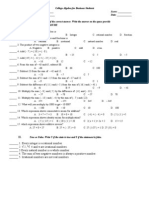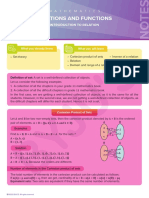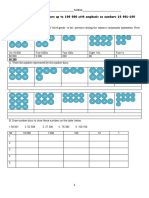0 ratings0% found this document useful (0 votes)
31 views1 Periodical Test in Mathematics 7
1 Periodical Test in Mathematics 7
Uploaded by
Diana Ann F. AganThe document appears to be a mathematics test covering topics like sets, operations, properties of numbers, rational and irrational numbers, and absolute value. It contains 15 multiple choice questions testing these concepts as well as 10 true/false statements and 5 absolute value calculations to complete. The test is assessing a student's understanding of fundamental mathematics principles across different subject areas within the domain.
Copyright:
© All Rights Reserved
Available Formats
Download as DOCX, PDF, TXT or read online from Scribd
1 Periodical Test in Mathematics 7
1 Periodical Test in Mathematics 7
Uploaded by
Diana Ann F. Agan0 ratings0% found this document useful (0 votes)
31 views2 pagesThe document appears to be a mathematics test covering topics like sets, operations, properties of numbers, rational and irrational numbers, and absolute value. It contains 15 multiple choice questions testing these concepts as well as 10 true/false statements and 5 absolute value calculations to complete. The test is assessing a student's understanding of fundamental mathematics principles across different subject areas within the domain.
Original Title
Exam
Copyright
© © All Rights Reserved
Available Formats
DOCX, PDF, TXT or read online from Scribd
Share this document
Did you find this document useful?
Is this content inappropriate?
The document appears to be a mathematics test covering topics like sets, operations, properties of numbers, rational and irrational numbers, and absolute value. It contains 15 multiple choice questions testing these concepts as well as 10 true/false statements and 5 absolute value calculations to complete. The test is assessing a student's understanding of fundamental mathematics principles across different subject areas within the domain.
Copyright:
© All Rights Reserved
Available Formats
Download as DOCX, PDF, TXT or read online from Scribd
Download as docx, pdf, or txt
0 ratings0% found this document useful (0 votes)
31 views2 pages1 Periodical Test in Mathematics 7
1 Periodical Test in Mathematics 7
Uploaded by
Diana Ann F. AganThe document appears to be a mathematics test covering topics like sets, operations, properties of numbers, rational and irrational numbers, and absolute value. It contains 15 multiple choice questions testing these concepts as well as 10 true/false statements and 5 absolute value calculations to complete. The test is assessing a student's understanding of fundamental mathematics principles across different subject areas within the domain.
Copyright:
© All Rights Reserved
Available Formats
Download as DOCX, PDF, TXT or read online from Scribd
Download as docx, pdf, or txt
You are on page 1of 2
1st Periodical test in Mathematics 7
Name: __________________________ Date: ______________
Section: ___________ Score: ______________
Part I. (Multiple choice)
Encircle the letter of the correct answer.
1. It is a well-defined group of objects.
A. set C. null set
B. subset D. universal set
2. Which of the following is a well-defined set?
A. A set of a good singers
B. A set of small numbers
C. A set of honest students in grade 7
D. A set of factors of 3.
3. Which illustrates the symbol for a null set?
A. ∩ C. ∅
B. ∪ D. ∁
4. Which of the following represents that A is the union of B?
A. A ∩ B C. A ∅ B
B. A ∪B D. A ∁ B
5. It is a symbol used to describe as an intersection of sets.
A. ∩ C. ∅
B. ∪ D. ×
6. It is the complement of set B where Set A = { 3 , 6 , 9 ,12 , 15 ,18 } and set B ={ 6 , 9 , 15 }.
A. { 6 , 9 , 15 } C. { 3 , 6 , 9 }
B. { 3 , 12, 18 } D. { 12 ,15 , 18 }
7. The sum of 8 and -15.
A. 23 C. 7
B. -23 D. -7
8. If -20 is diminished from 85, its difference is ______.
A. 65 C. 105
B. -65 D. -105
9. The product of -25 and 5.
A. 75 C. 85
B. -75 D. -85
10. _____ is the quotients when you divide -12 from -144.
A. 12 C. 14
B. -12 D. -14
11. Which of the following illustrates the communicative property of addition?
A. 7 + 0 = 7 C. (1 + 7) + 1 = 1 + (7 + 1)
B. 1 + 7 = 7 + 1 D. 1 (1 + 7) = (1 + 1) (1 + 7)
12. Which of the following is an example of associative property of multiplication?
A. 7 x 0 = 0 C. (1 x 1) 7 = 1 (1 x 7)
B. 1 x 7 = 7 x 1 D. 1 (1 x 7) = (1 x 1) (1 x 7)
13. Which of the following equations is an example of distributive property?
A. 7 x 0 = 0 C. (1 x 1) 7 = 1 (1 x 7)
B. 1 x 7 = 7 x 1 D. 1 (1 x 7) = (1 x 1) (1 x 7)
14. Any number divided by 1, gives the same quotient as the number itself. This is called the ______
property of division.
A. communicative C. identity
B. associative D. inverse
15. It is a property of multiplication that you multiply a number by its reciprocal.
A. communicative C. identity
B. associative D. inverse
Part II. True or False
Write T if the statement is true and F if the statement is false.
________1. Any number in the form of p/q where p and q are integers and q is not equal to 0 is a
rational number.
________ 2. It can be shown that a number is irrational if and only if its decimal representation is
repeating or terminating.
________ 3. In the decimal form 0.40, its fraction form is 2/3.
________ 4. The fraction form of the decimal 0.125 is 1/8.
________ 5. If 11/20 is expressed in decimal form, it results to 0.55.
________ 6. A principal root is the unique nonnegative square root of a nonnegative real number.
________ 7. The square roots of 16 are 4 and -4. This means that the principal root of 16 is 4.
________ 8. 5/-8 and -15/24 both represent the same rational numbers.
________ 9. The square root of 124 is an irrational number.
_______ 10. Pi ( π ) in an example of a rational number.
Part III. Gap-fill
Complete the gaps with the correct answer.
Find the absolute value of +3, -3, +7, -5, +9, -8, +4, -4. You may refer to the number above.
1. │+3│ =___ 3. │+9│ = ___
│-3│ = 3 4. │-8│ = ___
2. │+7│ = ___ │+4│ = 4
│-5│ = 5 5. │-4│ = ___
You might also like
- Modul PBD Maths DLP Year 1Document78 pagesModul PBD Maths DLP Year 1christinasuNo ratings yet
- HESI A2 Math Practice Tests: HESI A2 Nursing Entrance Exam Math Study GuideFrom EverandHESI A2 Math Practice Tests: HESI A2 Nursing Entrance Exam Math Study GuideNo ratings yet
- Third Summative Test in Mathematics 6Document3 pagesThird Summative Test in Mathematics 6vincevillamora2k11100% (2)
- 1st Preliminary Exam - Math 7Document3 pages1st Preliminary Exam - Math 7Yasser Obrero Rumay100% (2)
- Maths Grade 8studentDocument371 pagesMaths Grade 8studentsharmasanjivNo ratings yet
- 1 Periodical Test in Mathematics 7Document2 pages1 Periodical Test in Mathematics 7Diana Ann F. AganNo ratings yet
- Algebra QuizDocument1 pageAlgebra Quiznda0403No ratings yet
- Unit Tes Grade 7Document2 pagesUnit Tes Grade 7Mica Ella OlivarNo ratings yet
- Grade-4 Math WSDocument4 pagesGrade-4 Math WSak dNo ratings yet
- HSH First Quarter Examination (Assessment in Learning)Document5 pagesHSH First Quarter Examination (Assessment in Learning)kayezzy acesorNo ratings yet
- 1st Periodical Exam (Autosaved) 1111Document11 pages1st Periodical Exam (Autosaved) 1111Mara Ciela CajalneNo ratings yet
- First Periodic Test: RD RDDocument13 pagesFirst Periodic Test: RD RDJUVELYN BELLITANo ratings yet
- 1ST Quarter DiagnosticDocument3 pages1ST Quarter DiagnosticCory Ann PujanesNo ratings yet
- Math-7 - Q1 TQDocument4 pagesMath-7 - Q1 TQrey som velardeNo ratings yet
- Math 7 BDocument4 pagesMath 7 BLorelyn de la TorreNo ratings yet
- The Lord's Wisdom Academy of Caloocan Inc.: Diagnostic Test in Mathematics 9Document2 pagesThe Lord's Wisdom Academy of Caloocan Inc.: Diagnostic Test in Mathematics 9Vhilly JheykNo ratings yet
- Upper GradesDocument2 pagesUpper Gradesetolera-1No ratings yet
- First Quarter Exam Mathematics 7Document4 pagesFirst Quarter Exam Mathematics 7Elaine Rocel Ballucanag100% (1)
- 3rd Quarter Math G7 LAS (Week 1 - 2) PDFDocument14 pages3rd Quarter Math G7 LAS (Week 1 - 2) PDFGenesis NgNo ratings yet
- MATH7 1st PRELIM EXAMDocument4 pagesMATH7 1st PRELIM EXAMjohnmark.calmaNo ratings yet
- Math7 Q1 Week 4 EnhancedDocument17 pagesMath7 Q1 Week 4 EnhancedROWENA MAE FANUNCIONo ratings yet
- Math 7Document5 pagesMath 7Gayne SoterioNo ratings yet
- Reviewer in General Mathematics Part IiDocument1 pageReviewer in General Mathematics Part IiKristine CastroNo ratings yet
- Summative Test in Mathematics 7 - First QuarterDocument2 pagesSummative Test in Mathematics 7 - First QuarterCory Ann PujanesNo ratings yet
- Math 7 IbedDocument5 pagesMath 7 IbedGecille Joy FlagneNo ratings yet
- Francisco Ll. Laya Memorial Integrated School: 1 Periodical Test Grade 7Document2 pagesFrancisco Ll. Laya Memorial Integrated School: 1 Periodical Test Grade 7RAZEL C. SORIANO, MSciEdNo ratings yet
- Mathematics in The Modern World Chapter 2 QuizDocument6 pagesMathematics in The Modern World Chapter 2 QuizClaire FajardoNo ratings yet
- 4th MATH 7 4th PERIODICALDocument4 pages4th MATH 7 4th PERIODICALSijey ManingasNo ratings yet
- 1Document3 pages1Salome ViloriaNo ratings yet
- Republic of The Philippine6Document3 pagesRepublic of The Philippine6palopejoel1991No ratings yet
- Math 7 Quarter 1 Week 3 and 4Document5 pagesMath 7 Quarter 1 Week 3 and 4JIMA MASCARDONo ratings yet
- WorkBook - Mathematics 7Document8 pagesWorkBook - Mathematics 7Elton John Santos CapiliNo ratings yet
- Mathematics 7 Final ExaminationDocument2 pagesMathematics 7 Final ExaminationanalynNo ratings yet
- Mathematics 7 Final Examination - New1Document2 pagesMathematics 7 Final Examination - New1analynNo ratings yet
- Mathematics 7 Final ExaminationDocument2 pagesMathematics 7 Final ExaminationanalynNo ratings yet
- Mathematics 7 Final Examination - New1Document2 pagesMathematics 7 Final Examination - New1analynNo ratings yet
- 1ST Quarter Pre-Test 2020-2021Document2 pages1ST Quarter Pre-Test 2020-2021Donabel CariosNo ratings yet
- First Quarter Examination MATH 7Document3 pagesFirst Quarter Examination MATH 7ellton john pilarNo ratings yet
- Math STDocument5 pagesMath STRegine GomezNo ratings yet
- Mathematics 3Document4 pagesMathematics 3Yhiel Boado-CorpuzNo ratings yet
- Department of Education Pariaan National High SchoolDocument6 pagesDepartment of Education Pariaan National High SchoolJennylyn NamiaNo ratings yet
- Math 7 Summative Q1Document10 pagesMath 7 Summative Q1jacelmae.ederangoNo ratings yet
- Math 7 Q1 ExamDocument3 pagesMath 7 Q1 Exammerdicamae29No ratings yet
- 1 ST Quarterly ExaminationDocument15 pages1 ST Quarterly ExaminationDhanetth Kim ReyesNo ratings yet
- Second Quarter Summative 1Document2 pagesSecond Quarter Summative 1France MarkNo ratings yet
- G7 - Q1 - Periodical Test 2021-2022Document3 pagesG7 - Q1 - Periodical Test 2021-2022Jay Haryl PesalbonNo ratings yet
- Math 7 or Math 1 Summative TestDocument1 pageMath 7 or Math 1 Summative TestCris Capilayan76% (21)
- 6thgrademathdiagnostictest 1Document3 pages6thgrademathdiagnostictest 1Reham Mohamed Ahmed NoufalNo ratings yet
- A Kubot - AlgebraDocument15 pagesA Kubot - Algebrazxjm2k4rmbNo ratings yet
- Third Periodical TestDocument36 pagesThird Periodical Testgroxanne585No ratings yet
- MATH 10 SUMMATIVE Test SET-A Q2 2021Document2 pagesMATH 10 SUMMATIVE Test SET-A Q2 2021Mhar Gallien SerranoNo ratings yet
- 1st Grading Periodical Test in Math 7Document4 pages1st Grading Periodical Test in Math 7Mar Fred AroNo ratings yet
- Test in MathDocument2 pagesTest in Mathgerson acostaNo ratings yet
- LS3 MathDocument2 pagesLS3 MathAnnie EdralinNo ratings yet
- Math 10 - Division Summative Test 2023Document7 pagesMath 10 - Division Summative Test 2023cherish calachanNo ratings yet
- JJDocument4 pagesJJAjo Sjeaony TeancealNo ratings yet
- First Quarter Preliminary Assessment: Grade 7 MathematicsDocument5 pagesFirst Quarter Preliminary Assessment: Grade 7 MathematicsROSELYN SANTIAGONo ratings yet
- DIRECTIONS: Read Each Item Carefully and Solve For The Correct/best Answer. Use Capital LettersDocument2 pagesDIRECTIONS: Read Each Item Carefully and Solve For The Correct/best Answer. Use Capital LettersGishiella Nagal CabañogNo ratings yet
- G6 Q2 PT MathDocument8 pagesG6 Q2 PT MathNARITO IZIMAKINo ratings yet
- 2nd MIDTERM MATH 10Document3 pages2nd MIDTERM MATH 10Mard A. MacNo ratings yet
- Unified Summative Test No. 3 in Mathematics 6Document4 pagesUnified Summative Test No. 3 in Mathematics 6franzelle wilson50% (2)
- Math 154:: Elementary Algebra: Chapter 5 - Systems of Linear Equations in Two-VariablesDocument11 pagesMath 154:: Elementary Algebra: Chapter 5 - Systems of Linear Equations in Two-Variableshn317No ratings yet
- McGrawHill Grade 11 Functions Unit 3Document68 pagesMcGrawHill Grade 11 Functions Unit 3blabdude123100% (2)
- Practice Problem TrigDocument9 pagesPractice Problem TrigthendralNo ratings yet
- Mathex Year 10 2012Document4 pagesMathex Year 10 2012qwertyNo ratings yet
- Calculus 1 - Limits - Worksheet 4 - Evaluating Limits by Factoring - Part 2Document28 pagesCalculus 1 - Limits - Worksheet 4 - Evaluating Limits by Factoring - Part 2Diana HernandezNo ratings yet
- CBSE Clas 12 Relations and Functions Study NotesDocument127 pagesCBSE Clas 12 Relations and Functions Study NotesV T PRIYANKANo ratings yet
- Q1 Week 1 Visualizes Numbers Up To 100 000 With Emphasis On Numbers 10 001-100 000Document16 pagesQ1 Week 1 Visualizes Numbers Up To 100 000 With Emphasis On Numbers 10 001-100 000Jocelyn100% (2)
- Fractions 4 Go Deeper InvestigationsDocument7 pagesFractions 4 Go Deeper Investigationsonline serviceNo ratings yet
- Free Algebra2 Worksheets Unit14Document19 pagesFree Algebra2 Worksheets Unit14Mohamed ElsaadawiNo ratings yet
- Zeta Club - UKMT Intermediate Mentoring Questions: Number TheoryDocument2 pagesZeta Club - UKMT Intermediate Mentoring Questions: Number TheoryKayla YEUNG [10N17]No ratings yet
- Grade 7 Math Lesson 19: Verbal Phrases and Mathematical Phrases Learning GuideDocument5 pagesGrade 7 Math Lesson 19: Verbal Phrases and Mathematical Phrases Learning GuideMelanie Laraño-Baruiz VillameraNo ratings yet
- CBSE Class 10 Maths Chapter 4 - Quadratic Equations Important Questions 2022-23Document70 pagesCBSE Class 10 Maths Chapter 4 - Quadratic Equations Important Questions 2022-23ypimpalkar9No ratings yet
- Unit Iv Functions of Several Variables: Problem 1: Using The Definition of Total Derivative, Find The Value ofDocument20 pagesUnit Iv Functions of Several Variables: Problem 1: Using The Definition of Total Derivative, Find The Value ofSINNAPPARAJ SNo ratings yet
- CBSE Class 9 TrianglesDocument14 pagesCBSE Class 9 TrianglesSawarSagwalNo ratings yet
- Dicey FractionsDocument2 pagesDicey Fractionsapi-251259540No ratings yet
- CURRICULUM MAP FORM Math 8Document2 pagesCURRICULUM MAP FORM Math 8Jeric MatunhayNo ratings yet
- Number Theory A SolutionsDocument5 pagesNumber Theory A SolutionsThảo Minh NguyễnNo ratings yet
- Nat Reviewer Grade 10 1 QuarterDocument4 pagesNat Reviewer Grade 10 1 Quarteradhrianne100% (1)
- Revision Checklist Foundation TierDocument36 pagesRevision Checklist Foundation TierMeenaNo ratings yet
- LCM and GCFDocument5 pagesLCM and GCFJULIA ALLANANo ratings yet
- Grade 8 MathxDocument5 pagesGrade 8 Mathxapi-2542992270% (1)
- C1 Algebra F Completing The Square QuestionsDocument1 pageC1 Algebra F Completing The Square Questionsmustafa özserNo ratings yet
- JEE Mains 2020 Chapter Wise Tests:) K 2 J 3 I (T) K 2 J I (R + + +Document2 pagesJEE Mains 2020 Chapter Wise Tests:) K 2 J 3 I (T) K 2 J I (R + + +TEJA SINGHNo ratings yet
- Ncert Solutions Class 8 Math Chapter 3 Understanding QuadrilateralsDocument44 pagesNcert Solutions Class 8 Math Chapter 3 Understanding QuadrilateralssdevanNo ratings yet
- 2nd Term Syllabus TagsDocument5 pages2nd Term Syllabus TagsNauman AkramNo ratings yet
- PlanetCNC TNG GCodeDocument55 pagesPlanetCNC TNG GCodeboba ivanovNo ratings yet
- MATLAB Questions and Answers - 1Document13 pagesMATLAB Questions and Answers - 1Swastik ShuklaNo ratings yet
- Class 9Document3 pagesClass 9Ashish SrivastavaNo ratings yet

























































































